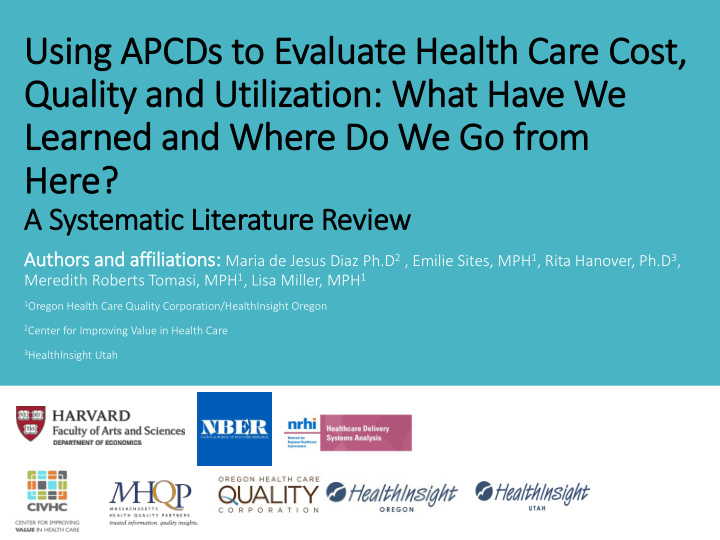



Usin ing APCDs to Evaluate Health Care Cost, Quality and Util ilization: What Have We Learned and Where Do We Go fr from Here? A A Systematic Lit iterature Revie iew filiations: Maria de Jesus Diaz Ph.D 2 , Emilie Sites, MPH 1 , Rita Hanover, Ph.D 3 , Auth thors an and affi Meredith Roberts Tomasi, MPH 1 , Lisa Miller, MPH 1 1 Oregon Health Care Quality Corporation/HealthInsight Oregon 2 Center for Improving Value in Health Care 3 HealthInsight Utah
Background • More than 15 states have implemented APCDs since 2003 • Multi-state collaborative research project that uses APCD data to describe the relationship between heath care cost and quality outcomes and the state’s health system characteristics, coordinated by the Network for Regional Healthcare Improvement Organization (NRHI) and National Bureau of Economic Research (NBER), and funded by the Agency for Healthcare Research and Quality (AHRQ). • Purpose: To assess how APCDs have been used for research purposes and to derive lessons on data applications, strengths and limitations.
Methods • Empirical studies conducted in the US and grey literature published between 2010-2017 • Query terms: combinations of all payer claims data or database, administrative or claims data and health care delivery, quality, cost, or system characteristics • Excluded proprietary and single-payer databases • Thirty one empirical studies met inclusion criteria • 14 pieces of grey literature
Literature Review Themes Cost Utilization Quality (8 articles) (15 articles) (10 articles)
Utilization Focus of studies: Use of prescription drugs Emergency department, Inpatient and outpatient services use Discretionary services Diagnostic imaging use Unique contribution of APCDs Longitudinal trends in utilization patterns at a granular level – ED visits by Census Tracts Population-based studies – Local practice patterns and prescription utilization
Cost Focus of studies: Total cost of care Inpatient services spending Cost of low-value care services Cost for specific surgical procedures or treatments Unique contribution of APCDs Ability to estimate total cost associated to all levels of care across organizational boundaries Access to data from all major payers in a region allows evaluation of market forces and dynamics Methods of working with APCD data to provide the best possible cost analysis
Quality Focus of studies Comparison of effectiveness of procedures and facilities: Readmissions, Mortality Assess outcomes of system-wide interventions: Pregnancy and Hypertension outcomes Assess population-level quality of care: Low-value care, preventive screening measures Unique contribution of APCD Comprehensive assessment of system performance Person-level data to identify patterns at a granular geographic level Objective evaluation of access and preventive screening other than self-reported measures
Using APCDs: General Findings Limited but growing number of published literature using state APCDs Great diversity of topics and uses of data Large datasets frequently used to describe patterns of infrequent conditions, procedures or prescriptions Many more opportunities of using APCDs as a broad, comprehensive and longitudinal set of data Thirteen articles used APCD data alongside other data sources Limitations related to nature of claims data, data completeness and regulations of data uses
Where do we go fr from here? Studying system performance Data goes beyond the walls of specific providers or specific type of services Data allows identifying networks of health care services Increased use – increased transparency – increased knowledge generation – decreased costs Opportunities to streamline data release processes Continue working on data completeness APCDs should inform health equity: methodology to report race/ethnicity and SES indicators Continue to develop processes that allow data sources to be integrated across sectors
Recommend
More recommend